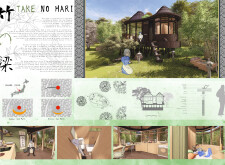5 key facts about this project
The architectural form utilizes a raised platform to minimize its footprint and facilitate drainage. It features a series of rounded roofs that contrast with the angular lines often found in contemporary design. This approach reinterprets traditional materials and shapes, creating a rhythm that resonates with its natural surroundings. Substantial glass elements allow for abundant natural light, fostering a connection between the indoor and outdoor spaces.
Responsive Design Elements
This project integrates several design strategies that distinguish it from conventional residential architecture. The use of locally sourced materials contributes to its sustainability and reduces environmental impact. Natural wood forms the primary structural element, offering warmth and a tactile quality that aligns with the surrounding forested environment. The incorporation of ceramic components in fixtures adds a layer of craftsmanship that recalls local artisanship.
The spatial arrangement promotes flexibility and interaction among residents. The open-plan living and dining area functions as a central gathering space, supported by strategically placed private quarters that ensure seclusion. The kitchen merges aesthetic simplicity with modern efficiency, embodying the project's dedication to a balanced home life.
Innovative Sustainability Practices
"Take No Hari" emphasizes ecological mindful living through various sustainable practices. The design employs passive solar principles, optimizing sun exposure through careful orientation and the use of overhangs to mitigate heat gain in warmer months. Seasonal changes are accounted for in the layout, ensuring that thermal comfort is maintained year-round.
Outdoor spaces are integrated into the living experience, with gardens that encourage biodiversity and enhance the aesthetic appeal. Paths around the property promote outdoor engagement, further fostering a connection with nature.
For a detailed exploration of the architectural plans, sections, and ideas that shape "Take No Hari," readers are encouraged to delve into the project presentation. This will provide further insights into the unique design approaches and architectural details that characterize this residence.























